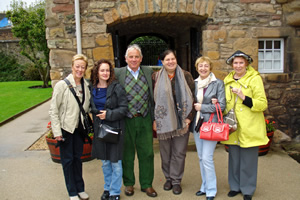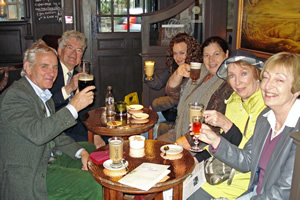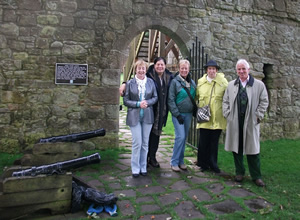Mary Queen of Scots Tour
A Tour by Jamie, Lord Sempill
No Scottish monarch is as well-known as Mary Queen of Scots. She is the endless subject of both fiction writers and historians. Her life and reign have been well recorded, and fortunately for us, many of the places at which she stayed or resided are still here today, nearly 500 years later.
I have created this 3 day tour, for those who are interested in visiting these historic properties, and who would like to know more about Mary, her reign and sixteenth century Scotland.
I also have a strong personal interest in her, as my family was actively involved in the royal court and the politics of the day. Robert, the 3rd Lord Sempill, was involved in many of the key events of her reign. As a Catholic, he had been one of Mary’s strong supporters, but ended up opposing her on the field of battle. His second son, John, married Mary Livingston, one of the 4 Marys, her ladies in waiting, so often referred to by historians and novelists.
Mary’s legacy as Queen of Scots would have disappeared into obscurity were it not for the many mysteries which turned her life story into one of the most tragic reigns in Scotland’s history.
The Tour Itinerary

Outside MQS house in Jedburgh
Day 1 – Edinburgh
Our first visit is to the most popular tourist attraction in Scotland. Edinburgh Castle. It was here that she gave birth to her son James, the future King of the United Kingdom of England and Scotland. It is also the home of Scotland’s Honours (crown jewels), which were present at her coronation in 1543, when she was only 9 months old. The castle is a formidable fortress that dominates the city, both then and now.
A short walk takes us to the Museum of Scotland. This recently renovated building is one of the top museums in the UK. It has an entire section devoted to the nation’s history. It has a wonderful selection of artefacts from her reign and a few of her personal possessions. The exhibits help to visualise aspects of life in sixteenth century Scotland.
The afternoon is devoted to Holyrood Palace, where we will be given a personal tour by one of the staff. This was her main residence, and it was here that she witnessed one of the most brutal episodes of her reign. The murder, of her Italian secretary, David Rizzio. Her chambers are pretty much as they were when she was living there, although the greater part of the Palace was built by her great grandson, Charles II.

The Sheeps Heid
Day 2 – The Borders
We start the day with a trip that takes us to the heart of the Borders, one of the most violent regions in sixteenth century Britain. We visit The Mary Queen of Scot’s House in Jedburgh, where she would have died, had it not been for the ministrations of her French physician. Today, the house is a museum dedicated to her memory. Although the tour focuses on her brief reign, the House provides a fuller picture of her life.
You will also be able to see the ruins of Jedburgh Abbey, one of the great medieval monastic buildings, built in the twelve century, and eventually destroyed by a combination of war against the English, and the Protestant Reformation.
We will then visit Traquair House, Scotland’s oldest inhabited house. This is still the home of the family, lifelong supporters of the Stuarts, whose owner at the time was the Captain of her royal guard. She visited the house on a few occasions to go hunting. The house still has the bed in which she slept, and a few of her personal effects. It also has its own brewery and craft shop.
The final stop is Craigmillar Castle, now a ruin, at which it is said, Mary was party to the plan to murder her husband, Lord Darnley. This deed undoubtedly hastened the end of her reign and saw her loose both the support of the people, and the majority of the nobility. The mystery of her involvement, in what became known as the Craigmillar bond, is still the subject of much debate.
We will deliberate the matter over some fine food and ale at The Sheep’s Heid Inn, in Duddingston, a stone’s throw from the castle and Scotland’s oldest surviving pub, dating back to 1362.

Main Entrance to Loch Leven Castle
Day 3 – Over The Forth
It is a day of contrasting architectural styles, and begins with a visit to Lochleven Castle, where she was held captive, and forced to abdicate in favour of her infant son. The castle is one of the earliest medieval tower houses built in Scotland. It sits on an island in the middle of the loch, which is a nature reserve and home to a wide variety of waterfowl.
We then proceed to Falkland Palace, a royal hunting lodge, built by her grandfather, James IV and her father, James V. It was probably one of Mary’s favourite residences. It has magnificent gardens and the oldest tennis court in Scotland.
In the afternoon we head to Stirling castle, recently restored by Historic Scotland, which gives the visitor a real sense of what it would have looked like at the time of her reign. This is greatly enhanced by having the guides dressed in period costume. It epitomises the power of the Stuart dynasty and is the most striking of all the Royal palaces.
 This tour was organised by Lord Sempill at Clan Chief Tours
This tour was organised by Lord Sempill at Clan Chief Tours
Price for the 3 day tour: £370 per person
This covers dinner and drinks for 2 nights. It also includes all entrance fees.
For more information:
E: jamiesempill@gmail.com
W: www.maryqueenscots.co.uk/
Also see Clan Chief Tours: clanchieftours.co.uk





